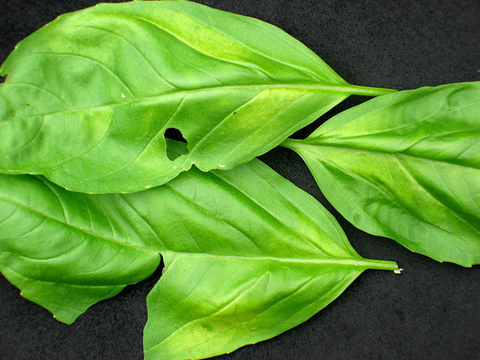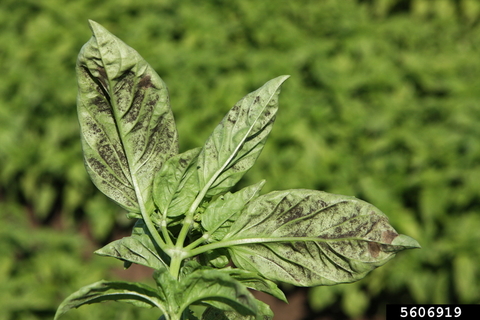Quick facts
- Basil downy mildew can spread rapidly and result in complete yield loss.
- Infection starts on lower leaves and moves up the plant. The disease causes pale yellow areas on the upper side of the leaf with velvety grey fuzz on the underside.
- The pathogen that causes basil downy mildew can be transmitted on seed, transplants or fresh leaves.
- Monitor all seedlings and transplants closely for yellowing leaves and gray downy growth on the lower surface of the leaf.
- Resistant varieties are the best way to prevent basil downy mildew.
How to tell downy mildew from other basil issues
- Infection starts on lower leaves and moves up the plant.
- Infected leaves first turn yellow in areas restricted by major veins. With time, the entire leaf turns yellow.
- Irregular black spots appear on infected leaves as they age.
- Fluffy gray spores grow on the underside of infected leaves.
Biology
- Basil downy mildew is caused by Peronospora belbahrii, which is a water mold as opposed to a true fungus.
- Basil downy mildew can be transferred by seed, transplants or fresh leaves. Infected transplants and leaves may not show symptoms if maintained in cool, dry conditions. Spores of P. belbahrii can also travel long distances on moist air currents.
- Peronospora belbahrii tolerates cool weather and can infect and produce spores in temperatures as low as 59°F. But it thrives in warm, humid conditions. As a result, the most devastating damage is often in late summer.
Peronospora belbahrii needs two different mating types to produce tough resting spores known as oospores. Only one mating type is present in the USA. As a result, no oospores form and the pathogen will not be able to survive Minnesota's harsh winters. This may change if the second mating type comes to the country.
Managing downy mildew in the home garden
- There are varieties of basil available with downy mildew resistance, often denoted in seed catalogs with the abbreviation DMR.
- Resistant varieties of basil include Rutgers Devotion DMR, Rutgers Obsession DMR, Rutgers Passion DMR, Rutgers Thunderstruck DMR, Amazel, Prospera Compact DMR (good for container production), and Prospera.
- Lower disease levels occur in red leaf basil varieties (O. basilicum purpurescens) and in lemon flavored varieties (O. citridorum). Varieties of hoary basil (O. americanum), have also shown resistance to downy mildew.
- Genovese basil is the most susceptible.
- Monitor all seedlings and transplants closely for yellowing leaves and gray downy growth on the lower surface of the leaf.
- Remove and destroy immediately any plant with basil downy mildew.
- Increase row width and distance between plants to provide good air movement between plants to allow leaves to dry quickly after rain, dew or irrigation.
- If sprinkler irrigation is the only option, water deeply and infrequently early on a sunny day so leaves dry quickly in the sun.
If growing basil in small pots, move pots indoors overnight during periods of high humidity or on rainy days to reduce infection. Read more from Cornell University about how to reduce infections.
Because of this pathogen’s unique biology, products available to homeowners are not effective.
Managing downy mildew on the farm
You can see if basil downy mildew is circulating locally by checking the Basil Ag Pest Monitor map.
- Genovese basil and other sweet varieties of the species O. basilicum are the most susceptible type of basil. Resistant varieties have recently been developed (see chart below).
- Other types of basil are more tolerant to downy mildew. However, they often have different leaf color and flavor, and so they may not be a good substitute for Genovese and other sweet types, depending on customer preference.
- Growers should choose the most resistant variety that is acceptable to their market.
Susceptibility of basil varieties to basil downy mildew
| Level of resistance | Scientific name | Varieties |
|---|---|---|
| Highly susceptible | Ocimum basilicum | Genovese, Nufar, Italian Large Leaf, Queenette, Superbo, Poppy Joe's and many others |
| Moderately susceptible | O. basilicum purpurescens | Red Rubin, Red Leaf |
| Moderately susceptible | O. citridorum | Lemon std., Mrs. Burn's Lemon, Lemona & Lime |
| Less susceptible | O. americanum | Blue Spice, Spice & Blue, Spice F1 |
| Resistant | Ocimum basilicum | Rutgers Devotion DMR, Rutgers Obsession DMR, Rutgers Passion DMR, Rutgers Thunderstruck DMR, Amazel, Prospera Compact DMR, and Prospera. |
- Monitor all seedlings and transplants closely for yellowing leaves and gray downy growth on the lower surface of the leaf.
- If any plant has basil downy mildew, remove and destroy the plant immediately.
- Increase row width and distance between plants to provide good air movement between plants to allow leaves to dry quickly after rain, dew or irrigation.
- If sprinkler irrigation is the only option, water deeply and infrequently early on a sunny day so leaves dry quickly in the sun.
- In greenhouse and hoop house production, adjust ventilation to reduce humidity.
- Promptly till under diseased plants that are from past harvests to reduce the spread of the pathogen from one plant to another through spores produced on infected leaves.
- The pathogen that causes downy mildew is not a true fungus but a water mold. As a result, many common fungicides provide no control against downy mildew.
- Certain fungicides can protect plants from basil downy mildew. Begin sprays before infection occurs to be effective.
- In one study, extreme periods of rainy, wet weather resulted in no control by any fungicide combination.
- Read and follow all label instructions whenever applying a fungicide. Use tank mixes and rotation between fungicides to reduce the risk of fungicide resistance.
Refer to the Midwest Vegetable Production Guide for current product recommendations.
CAUTION: Mention of a pesticide or use of a pesticide label is for educational purposes only. Always follow the pesticide label directions attached to the pesticide container you are using. Be sure that the plant you wish to treat is listed on the label of the pesticide you intend to use. And observe the number of days between pesticide application and when you can harvest your crop. Remember, the label is the law.
Reviewed in 2022



